
Kyushu is the third-largest island of Japan's five main islands and the most southerly of the four largest islands. In the past, it has been known as Kyūkoku, Chinzei and Tsukushi-no-shima. The historical regional name Saikaidō referred to Kyushu and its surrounding islands. Kyushu has a land area of 36,782 square kilometres (14,202 sq mi) and a population of 14,311,224 in 2018.

Okinawa Prefecture is a prefecture of Japan. Okinawa Prefecture is the southernmost and westernmost prefecture of Japan and has a population of 1,457,162 and a geographic area of 2,281 km2.

The Ryukyuan people are a Japonic-speaking East Asian ethnic group native to the Ryukyu Islands, which stretch between the islands of Kyushu and Taiwan. Administratively, they live in either the Okinawa Prefecture or the Kagoshima Prefecture within Japan. They speak one of the Ryukyuan languages, considered to be one of the two branches of the Japonic language family, the other being Japanese and its dialects. Hachijō is sometimes considered by linguists to constitute a third branch.
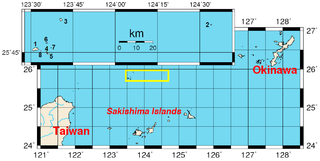
The Senkaku Islands are a group of uninhabited islands in the East China Sea, administered by Japan. They are located northeast of Taiwan, east of China, west of Okinawa Island, and north of the southwestern end of the Ryukyu Islands. They are also known as the Pinnacle Islands or the Diaoyu Islands in China and as the Tiaoyutai Islands in Taiwan.
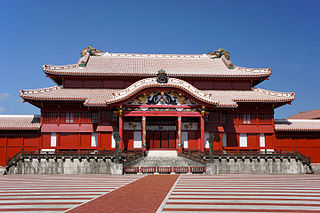
This article is about the history of the Ryukyu Islands southwest of the main islands of Japan.
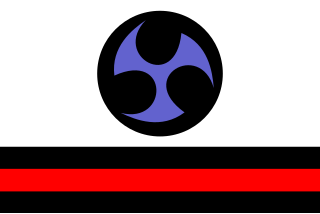
The Ryukyu Kingdom was a kingdom in the Ryukyu Islands from 1429 to 1879. It was ruled as a tributary state of imperial Ming China by the Ryukyuan monarchy, who unified Okinawa Island to end the Sanzan period, and extended the kingdom to the Amami Islands and Sakishima Islands. The Ryukyu Kingdom played a central role in the maritime trade networks of medieval East Asia and Southeast Asia despite its small size. The Ryukyu Kingdom became a vassal state of the Satsuma Domain of Japan after the invasion of Ryukyu in 1609 but retained de jure independence until it was transformed into the Ryukyu Domain by the Empire of Japan in 1872. The Ryukyu Kingdom was formally annexed and dissolved by Japan in 1879 to form Okinawa Prefecture, and the Ryukyuan monarchy was integrated into the new Japanese nobility.

The Japanese archipelago is a group of 14,125 islands that form the country of Japan. It extends over 3,000 km (1,900 mi) from the Sea of Okhotsk in the northeast to the East China and Philippine Seas in the southwest along the Pacific Ocean coast of the Eurasian continent, and consists of three island arcs from north to south: the Northeastern and Southwestern Japan Arcs, and the Ryukyu Island Arc. The Daitō Islands, Izu–Bonin–Mariana Arc, Kuril Islands, and the Nanpō Islands neighbor the archipelago.
George H. Kerr, also known in Taiwan as 葛超智, was a United States diplomat during World War II, and in later years he was an author and an academic. His published works and archived papers cover "economic and political affairs in Taiwan in the 1930s and 1940s, Taiwan's transition from Japanese rule before and during World War II to postwar Chinese rule, Taiwanese rebellion against Chinese rule in 1947, and U.S. foreign policy toward Taiwan." His works also include "information about economic and political conditions in Okinawa and the Ryukyu Islands after World War II."

The Yaeyama Islands are an archipelago in the southwest of Okinawa Prefecture, Japan, and cover 591.46 square kilometres (228.36 sq mi). The islands are located southwest of the Miyako Islands, part of the Ryukyu Islands archipelago. The Yaeyama Islands are the remotest part of Japan from the main islands and contain Japan's most southern (Hateruma) and most western (Yonaguni) inhabited islands. The city of Ishigaki serves as the political, cultural, and economic center of the Yaeyama Islands.

Liuqiu, also known by several other names, is a coral island in the Taiwan Strait about 13 kilometers (8 mi) southwest of the main island of Taiwan. It has an area of 6.8 km2 (2.6 sq mi) and approximately 13,000 residents, the vast majority of whom share only 10 surnames. It is administered as a township of Pingtung County in Taiwan Province, Republic of China. As of 2019 the township chief is Chen Lung-chin.
The Liuqiu or Lewchew of the Book of Sui and other medieval Chinese texts was a realm said to have existed in the East China Sea. During the 18th and 19th centuries, it was referred to as Liukiu in English; and, Lieou-kieou in French. It is variously identified with Taiwan Island, the Penghu or Pescadore Islands, and the Ryukyu Archipelago.

The Japanese punitive expedition to Taiwan in 1874, referred to in Japan as the Taiwan Expedition and in Taiwan and Mainland China as the Mudan incident, was a punitive expedition launched by the Japanese ostensibly in retaliation for the murder of 54 Ryukyuan sailors by Paiwan aborigines near the southwestern tip of Taiwan in December 1871. In May 1874, the Imperial Japanese Army and Imperial Japanese Navy attacked the indigenous Taiwanese peoples in southern Taiwan and retreated in December after the Qing dynasty agreed to pay an indemnity of 500,000 taels. Some ambiguous wording in the agreed terms were later argued by Japan to be confirmation of Chinese renunciation of suzerainty over the Ryukyu Islands, paving the way for de facto Japanese incorporation of the Ryukyu in 1879.

The Ryukyu Islands, also known as the Nansei Islands or the Ryukyu Arc, are a chain of Japanese islands that stretch southwest from Kyushu to Taiwan: the Ōsumi, Tokara, Amami, Okinawa, and Sakishima Islands, with Yonaguni the westernmost. The larger are mostly high islands and the smaller mostly coral. The largest is Okinawa Island.
Shō Hashi was the last King of Chūzan and the first king of the Ryukyu Kingdom, uniting the three polities of Chūzan, Hokuzan, and Nanzan by conquest and ending the Sanzan period.
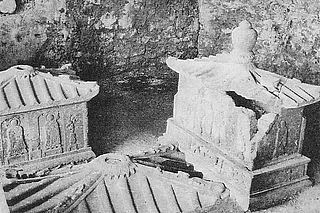
Eiso was a semi-legendary ruler of Okinawa Island. He was the founding monarch of the Eiso dynasty.
Gyorin was a neo-Confucian term developed in Joseon Korea. The term was intended to identify and characterize a diplomatic policy which establishes and maintains amicable relations with neighboring states. It was construed and understood in tandem with a corollary term, which was the sadae or "serving the great" policy towards Imperial China.
The Ryukyu Islands are a volcanic arc archipelago.
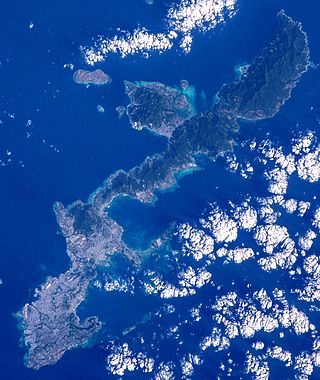
Okinawa (沖縄) is a name with multiple referents. The endonym prototypically refers to Okinawa Island in southwestern Japan. Today it can cover some surrounding islands and, more importantly, can refer to Okinawa Prefecture, a much larger administrative division of Japan, although the people from the Miyako and Yaeyama Islands still feel a strong sense of otherness to Okinawa.
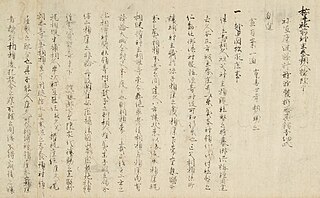
The Hyōtō Ryūkyū-koku ki (漂到流球国記) was a book written by Japanese Buddhist monk Keisei in 1244. He interviewed travelers who, during a sea voyage to Song China, drifted to what they believed to be Ryūkyū. It reflects the long-lasting Japanese perception of Ryūkyū as the land of man-eating demons.
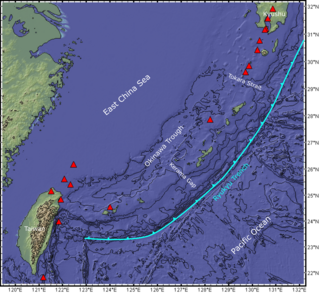
The Ryukyu Arc is an island arc which extends from the south of Kyushu along the Ryukyu Islands to the northeast of Taiwan, spanning about 1,200 kilometres (750 mi). It is located along a section of the convergent plate boundary where the Philippine Sea Plate is subducting northwestward beneath the Eurasian Plate along the Ryukyu Trench. The arc has an overall northeast to southwest trend and is located northwest of the Pacific Ocean and southeast of the East China Sea. It runs parallel to the Okinawa Trough, an active volcanic arc, and the Ryukyu Trench. The Ryukyu Arc, based on its geomorphology, can be segmented from north to south into Northern Ryukyu, Central Ryukyu, and Southern Ryukyu; the Tokara Strait separates Northern Ryukyu and Central Ryukyu at about 130˚E while the Kerama Gap separates Central Ryukyu and Southern Ryukyu at about 127 ˚E. The geological units of the arc include igneous, sedimentary, and metamorphic rocks, ranging from the Paleozoic to Cenozoic in age.














